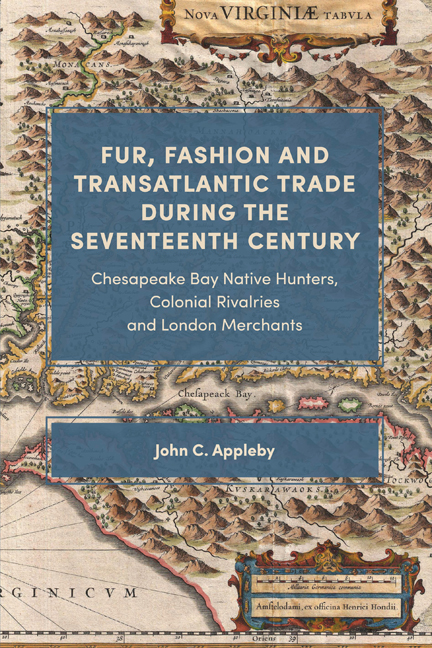 Fur, Fashion and Transatlantic Trade during the Seventeenth Century
Fur, Fashion and Transatlantic Trade during the Seventeenth Century Book contents
- Frontmatter
- Contents
- Acknowledgements
- A Note on Conventions
- Abbreviations
- Maps
- Introduction
- 1 Fur and Fashion: The Infrastructure of a New Trade
- 2 Commerce and Colonization: The Emergence of the Fur Trade in Chesapeake Bay
- 3 Trade and Rivalry: The Promise of Expansion and Innovation during the 1630s
- 4 Trade, Rivalry and Conflict during a ‘Time of Troubles’ from 1640 to 1660
- 5 Commercial Change and Conflict: Contrasting Experiences after 1650
- 6 Trade, Consumption and Industry: Transatlantic Constraints on the Bay Trade
- Conclusion
- Appendix
- Select Bibliography of Works Consulted
- Index
5 - Commercial Change and Conflict: Contrasting Experiences after 1650
Published online by Cambridge University Press: 15 December 2020
- Frontmatter
- Contents
- Acknowledgements
- A Note on Conventions
- Abbreviations
- Maps
- Introduction
- 1 Fur and Fashion: The Infrastructure of a New Trade
- 2 Commerce and Colonization: The Emergence of the Fur Trade in Chesapeake Bay
- 3 Trade and Rivalry: The Promise of Expansion and Innovation during the 1630s
- 4 Trade, Rivalry and Conflict during a ‘Time of Troubles’ from 1640 to 1660
- 5 Commercial Change and Conflict: Contrasting Experiences after 1650
- 6 Trade, Consumption and Industry: Transatlantic Constraints on the Bay Trade
- Conclusion
- Appendix
- Select Bibliography of Works Consulted
- Index
Summary
In 1679 John Banister, minister and naturalist, informed one of his correspondents that the Indian trade in Virginia, ‘once great & good’, had ‘dwindled almost into Nothing’. Dismissing the opinion of many settlers who identified interethnic commerce as the source of recent troubles in the colony, he claimed it was ‘rightly considered our Vinculum Pacis’, or a bond of peace, with the Indians. Writing from the fort located at the falls on the James River, where William Byrd was developing commercial relations with inland groups, Banister envisioned a commercial pathway based on native demand for ‘many Things which they wanted … for their use & ornament’. Despite this appealing prospect, twenty years later a proposal to launch an ambitious fur-trading venture in Virginia failed to gather support on either side of the Atlantic. The response in London indicated that the primary propose of the colony was the cultivation of tobacco. Such a perspective reflected the consolidation of the Chesapeake colonies as agricultural economies sustained by an expanding transatlantic trade. Shipments of tobacco into London, which amounted to two million pounds in 1640, reached seven million in 1663, and climbed to 11 million by 1676. Commercial expansion, based on servant and slave labour, was accompanied by population growth. Sir William Berkeley claimed that the colonial population of Virginia was at least 40,000 by the mid-1670s, while that of its northern neighbour was about 20,000 by 1685. Socio-economic change increased the hunger for land, intensifying the pressure on native communities, leading to a sharp demographic decline in neighbouring groups. In combination with the ever-widening impact of interethnic trade, it encouraged Indian re-location and re-structuring, with the association of survivor or refugee groups, or their assimilation by others, reflected in re-naming and cultural adaptation.
The development of a colonial tobacco culture, alongside the cultivation of grain and the raising of stock, were accompanied by changes to the fur trade. As commerce within the confines of the Bay declined, trading ambitions were either re-directed to regions beyond or re-shaped by Indian hostility and conflict. At the same time, the gradual disengagement of former colonial rivals was both cause and consequence of the emergence of divergent patterns, demonstrated by exploration and expansion in Virginia and stagnation and conflict in Maryland.
- Type
- Chapter
- Information
- Fur, Fashion and Transatlantic Trade during the Seventeenth CenturyChesapeake Bay Native Hunters, Colonial Rivalries and London Merchants, pp. 165 - 204Publisher: Boydell & BrewerPrint publication year: 2021


